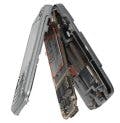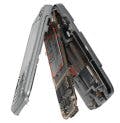Although high-power LEDs are being used in handsets, it is difficult to supply sufficient current from the battery to drive the LEDs to the level required for adequate light output during the flash "event".
The CAP-XX BriteFlash power architecture uses a low-current charge pump (boost converter) to charge the supercapacitor to 5.5 volts, then the supercapacitor drives the LED at very high current for the flash pulse.
The supercapacitor approach makes it possible to drive four LEDs at close to 1 A each, while only drawing a maximum of 300 mA from the battery. The supercapacitor is charged with a current of 250 mA to support a recovery time between flashes of approximately 2 seconds. CAP-XX says that this is less time than the LED needs for thermal recovery between flashes.
Most solutions for driving high-power LEDs use special-purpose boost converter ICs that are capable of delivering around 1 A to a single LED. Without a supercapacitor, the boost converter has to be sized for peak flash current, while in the CAP-XX case a lower-cost, smaller boost converter or charge pump is needed to supply the supercapacitor with its low charging current of 250 mA.
While the original LEDs drew 70 mA per die (or 1 W in total), the supercapacitor drove the new LEDs at 0.9 A each, or 15 W in total, with a flash duration of 160 ms.
The photos in Figure 2 from the unmodified phone (dark) and the modified phone with supercapacitor, at a distance of 2 m with no ambient light, clearly show the difference in flash performance.
“Greater than 2-megapixel camera phones require a high-intensity flash in medium to low light conditions to ensure good pictures,” said Anthony Kongats. “Some solutions are available but lack adequate power to produce quality photos in all light conditions. Our BriteFlash power architecture completes the equation with the power to drive today’s LEDs.”
The total cost of the CAP-XX BriteFlash solution is US $4 to $5 including the LEDs, supercapacitors and circuitry. The supercapacitor alone costs $1.50 for the single-cell solution and $2.50 for the dual-cell one in quantities of 500,000 to 1 million.
Kongats adds that CAP-XX is working with flash/LED driver suppliers to develop supercapacitor-optimized charge pump LED drivers to further increase camera phone power subsystem integration and reduce costs.
CAP-XX, which develops and manufactures supercapacitors, is a private company based in Sydney, Australia, with additional production facilities in Malaysia.









